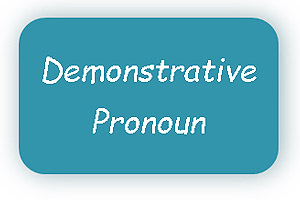Define demonstrative pronoun:
A demonstrative pronoun is a sort of pronoun that is used to refer to certain individuals, things, or concepts. They are used to indicate the proximity or distance of the referent from the speaker or the listener. Demonstrative pronouns in English include this, that, these, and those.
When referring to a singular noun or a thought that is near the speaker, the pronoun “This” is employed. As in, “This book is mine.” It denotes a temporal or spatial object that is close to the speaker.
When referring to a singular noun or an idea that is further distant from the speaker, the pronoun “that” is employed. An example might be, “That house is beautiful.” It denotes something farther out in time or space.
The pronoun “these” is used to refer to plural nouns or ideas that are close to the speaker. For example, “These cookies are delicious.” It indicates multiple items or ideas nearby.
When referring to concepts or plural nouns that are further removed from the speaker, the pronoun “those” is employed. A good example would be “Those cars are expensive.” It suggests a number of farther-off things or concepts.
Demonstrative pronouns help to clarify the specific objects or ideas being referred to and provide context for the conversation or text. They play an essential role in effective communication by pointing out and distinguishing particular entities in relation to the speaker’s perspective.
This These That Those:
There are four demonstrative pronouns of singular/Plural.
| Singular | Plural |
| This | These |
| That | Those |
a) this is my brother John.
b) that is my parrot.
On telephone call.
Hello,’ this is David here.
I am is insignificantly more formal than This is and is more likely to be used when the caller is a stranger to the other person.
- Proximity: Demonstrative pronouns indicate the proximity or distance of the noun they replace. This and these refer to such things that are close to the speaker for example, while that and those refer to things that are farther away.
- Example: This is my book. (The book is close to the speaker.)
- Singular vs. Plural: This and that are used with singular nouns, while these and those are used with plural nouns.
- Example: That is my car. (Referring to a singular car.) Those are my books. (Referring to multiple books.)
- Specificity: Demonstrative pronouns point to specific entities, emphasizing a particular object or idea.
- Example: This is the solution to the problem. (Emphasizing a specific solution.)
- Agreement: Demonstrative pronouns should agree in number with the noun they replace.
- Example: This is my pen. (Singular noun, singular pronoun.) These are my pens. (Plural noun, plural pronoun.)
- Antecedent: The noun being replaced by the demonstrative pronoun is called the antecedent. The pronoun should be used in place of the antecedent to avoid repetition.
- Example: John has two cars. This one is his favorite. (Using this to refer back to the car.)
- Remember that demonstrative pronouns help indicate the location, number, and specificity of the noun being referred to, allowing for clearer and more concise communication.
Demonstrative pronoun examples:
- This is My home.
- This Table is broken.
- That is My Bicycle.
- No, that is not mine.
- Meet these friends.
- Those birds are flying from the North.
- These are old classrooms.
- This is my pen.
- That is your car.
- These are my books.
- Those are your shoes.
- This is delicious!
- That is interesting.
- These are my friends.
- Those are your keys.
- This is my house.
- That is your cat.
- These are my parents.
- Those are your glasses.
- This is my laptop.
- That is your backpack.
- These are my clothes.
- Those are your headphones.
- This is my phone.
- That is your hat.
- These are my classmates.
- Those are your gloves.
- This is my wallet.
- That is your bicycle.
- These are my colleagues.
- Those are your socks.
- This is my cup.

